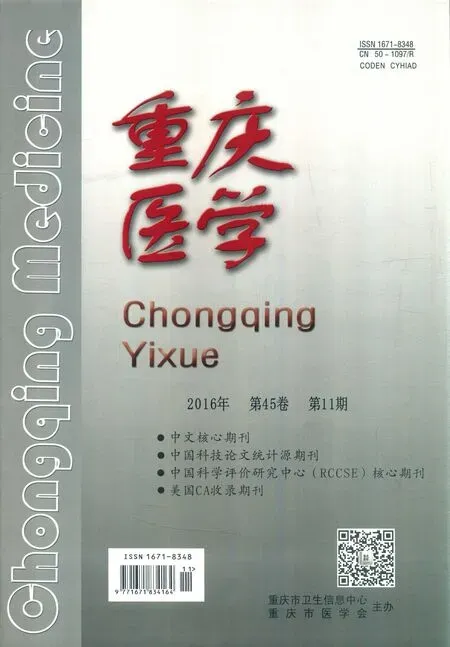FOXC2對結直腸癌細胞上皮-間質轉化及侵襲能力的影響*
蔡娟娟,崔艷梅,丁彥青,廖雯婷
(南方醫科大學基礎醫學院病理系,廣州 510515)
?
FOXC2對結直腸癌細胞上皮-間質轉化及侵襲能力的影響*
蔡娟娟,崔艷梅,丁彥青,廖雯婷△
(南方醫科大學基礎醫學院病理系,廣州 510515)
[摘要]目的明確叉頭框C2(FOXC2)在結直腸癌細胞侵襲遷移中的作用。方法采用逆轉錄病毒感染的方法建立FOXC2穩定過表達的結直腸癌細胞株(SW480/FOXC2)及空載體對照細胞株(SW480/pBabe),顯微鏡下觀察結直腸癌細胞形態改變。Western blot及免疫熒光法檢測FOXC2過表達細胞株及對照細胞株中E-cadherin、Vimentin、N-cadherin的表達情況;Transwell侵襲小室實驗檢測結直腸癌細胞遷移能力的改變。結果過表達后SW480細胞的形態發生了明顯的變化,從原來典型的上皮細胞形狀變成長梭形,類似于成纖維細胞的形態;Western Blot及免疫熒光檢測結果顯示,FOXC2過表達后上皮分子標志物E-cadherin表達明顯下調,而間質分子標志物Vimentin及N-cadherin表達顯著上調;Transwell侵襲實驗結果顯示,FOXC2過表達后結直腸癌細胞侵襲潛能明顯增強。結論FOXC2過表達能誘導結直腸癌細胞SW480發生上皮-間質轉化并增強其侵襲能力。
[關鍵詞]結直腸腫瘤;叉頭框C2;上皮-間質轉化;侵襲
結直腸癌是全球發病率最高的惡性腫瘤之一,全球每年新發病例已增至100萬,其發病率以4.2%的速度螺旋遞增[1-2]。轉移是導致結直腸癌治愈率低、死亡率高的主要原因[3-4]。上皮-間質轉化是腫瘤轉移的重要步驟,使細胞失去上皮細胞表型獲得間皮細胞表型,促使細胞轉移至鄰近組織和遠端器官,引起細胞的侵襲轉移[5-6]。叉頭框C2(forkhead box C2,FOXC2)又名間充質叉頭框1(mesenchyme forkhead 1,MHF1),屬于叉頭框轉錄因子超家族成員,最初發現于小鼠腦組織[7]。人類FOXC2基因定位于16q24.3,其編碼的蛋白參與調節包細胞分化、代謝、發育、增殖和凋亡等不同的細胞過程[8]。近年來的研究表明,FOXC2在乳腺癌、胃癌、非小細胞癌和食管癌中高表達,其異常高表達與腫瘤的生長、侵襲和轉移能力密切相關[9-14]。然而,FOXC2在結直腸癌侵襲轉移中的作用及分子機制尚未研究清楚。本研究旨在探討FOXC2對結直腸癌細胞上皮-間質轉化及侵襲遷移潛能的影響。
1材料與方法
1.1材料
1.1.1細胞株人結腸癌細胞株SW480,人胚腎細胞株293Ft為南方醫科大學病理學實驗室自存。
1.1.2實驗試劑胎牛血清、RPMI-1640購自美國Gibico公司,PVDF膜購自美國Millipore公司,Transwell小室購自美國BD公司,E-cadherin、Vimentin、N-cadherin抗體購自美國Bioworld公司,兔二抗及鼠二抗購自美國Thermo公司,α-Tubulin購自北京銳抗公司。
1.2方法
1.2.1構建穩定細胞株(1)培養并傳代病毒細胞293Ft細胞,轉染前24 h,取對數生長期細胞,胰酶消化后,按每孔5×105個接種于6孔板中。當細胞生長成80%時進行轉染。(2)將重組質粒及陰性對照質粒各25 μg,慢病毒包裝質粒25 μg分別加入EP管中,依次加入Gibico H2O至150 μL,加入CaCl2250 μL,最后加入200 μL緩沖液(2×HBS,pH 7.0),室溫靜置25 min后加入293Ft細胞中,隨后加入氯喹30 μL。(3)24 h后,收集細胞培養上清液,用0.45 μm孔徑的濾器(Millipore公司產品)過濾,收集濾液,按4 μg/mL加入polybrene,混勻后,加至提前1 d接種于6孔細胞培養板中的待轉染細胞(4×105個/孔)上,每隔4 h收集一次病毒上清液并加入待轉染細胞中,連續感染3次。(4)感染結束后24~48 h,用含1 μg/mL嘌呤霉素的培養基篩選陽性克隆,連續篩選3 d,每天換液。(5)收集以上細胞株的RNA和蛋白,用熒光定量PCR和Western blot方法鑒定。
1.2.2Western blot蛋白用10.5%SDS-PAGE凝膠進行電泳分離,濕法轉印至PVDF膜上,轉膜結束后兔抗人FOXC2抗體,E-cadherin、Vimentin、N-cadherin單克隆抗體孵育過夜,次日加入辣根過樣化物酶標記的二抗,于室溫孵育45 min后,洗脫抗體,常規顯色發光。
1.2.3免疫熒光實驗細胞轉染后24 h消化計數,爬片,漂洗,固定,再漂洗,加一抗過夜,次日加入帶熒光二抗,避光反應1 h,漂洗,染色,激光共聚焦顯微鏡下觀察。
1.2.4Transwell遷移實驗細胞轉染后24 h消化計數,加入放置了Transwell小室的24孔板中,上層小室加入含5%胎牛血清的培養基,下層小室加入含20%胎牛血清的培養基,孵育48 h,取出,固定,染色,顯微鏡下隨機選取視野拍照計數。
1.3統計學處理采用SPSS21.0統計軟件進行分析,兩獨立樣本t檢驗,以P<0.05為差異有統計學意義。
2結果
2.1FOXC2過表達后結直腸癌細胞形態變化FOXC2穩定過表達后,SW480細胞的形態發生了明顯的變化,從原來典型的上皮細胞形狀變成長梭形,類似于成纖維細胞的形態。見圖1。
2.2FOXC2過表達后上皮-間質轉化標志物的變化Western blot實驗顯示,與對照組相比,FOXC2過表達后,上皮標記物E-cadherin的表達下調,而間質標記物Vimentin,N-cadherin表達上調(圖2)。免疫熒光實驗顯示,與對照組相比,FOXC2過表達后,上皮標記物E-cadherin的表達強度下調,而間質標記物Vimentin、N-cadherin表達強度上調(圖3)。

圖1 FOXC2過表達SW480的形態學變化

圖2 Western blot檢測FOXC2過表達細胞株與對照組細胞株中上皮-間質轉化標志物的表達
2.3FOXC2過表達后結直腸癌細胞侵襲遷移潛能的變化Transwell遷移實驗結果顯示,與對照組相比,結直腸癌SW480細胞FOXC2過表達后遷移的細胞明顯增多,差異有統計學意義(P<0.01)。見圖4。

圖3 免疫熒光法檢測FOXC2過表達細胞株及對照細胞株中E-cadherin、Vimentin、N-cadherin的表達情況(×60)

圖4 Transwell侵襲小室實驗檢測結直腸癌細胞遷移能力的改變(×20)
3討論
腫瘤轉移是一個多步驟、多階段的復雜過程,包括腫瘤微環境的改變、細胞遷移、細胞運動及腫瘤血管形成等過程[15-16]。近年來發現,上皮-間質轉化的異常激活存在于多種病理性過程中,包括上皮來源的腫瘤的纖維化和轉移性擴散[17]。在腫瘤中,上皮-間質轉化使得上皮細胞從原發腫瘤脫落下來,侵襲到周圍基質中,因此,腫瘤性的上皮-間質轉化是轉移進展最初階段的重要步驟之一[18]。在侵襲性腫瘤中,有多種信號通路和EMT誘導基因的異常激活,包括TGF-α、Wnt/β-catenin信號通路、Snail/Slug轉錄因子家族、Twist轉錄因子家族等[19]。
叉頭框家族蛋白是在進化過程中高度保守的轉錄因子家族,該轉錄因子家族成員共包含了17個亞家族(FOXA-R),目前在人類發現至少有40多個成員。FOX蛋白家族成員在多種生物學進程包括代謝、發育、分化、增殖、凋亡、轉移、侵襲和壽命中都起著重要的作用。因此,FOX功能的失調可改變細胞的命運和促進腫瘤的發生。大量的體內實驗證明,FOX家族蛋白在發育和維持組織穩態中起著重要作用[20]。研究表明,FOXC2在胚胎發育、機體代謝調節、脈管系統的發育及腫瘤血管生成中起著重要的作用[21-23]。近年來,越來越多的研究表明,FOXC2 在腫瘤發生及轉移過程中起不可忽略的作用。研究顯示,FOXC2通過直接誘導趨化因子4受體和整合素3,從而促進腫瘤血管及淋巴管形成[24]。有研究表明FOXC2過表達促進間葉細胞的分化,誘導基質金屬蛋白酶-2(MMP2)和基質金屬蛋白酶-9(MMP9)的表達[25]。有研究顯示P120-catenin 是腫瘤上皮細胞中穩定E-cadherin 的一種調節蛋白,FOXC2 能下調P120-catenin 表達,從而間接抑制上皮標志物E-cadherin 表達, 導致腫瘤發生上皮-間質轉化[26]。 在乳腺癌中,FOXC2的表達與上皮-間質轉化和干細胞特性相關,干擾FOXC2表達能抑制細胞的間質表型和相關的侵襲行為及干細胞特性,而FOXC2過表達又能誘導腫瘤干細胞特性及乳腺癌細胞的轉移[27]。本研究的實驗結果提示,FOXC2過表達促使結直腸癌SW480細胞發生顯著的上皮-間質轉化形態學改變。同時,FOXC2過表達后,SW480細胞中上皮細胞標志物E-cadherin表達下調,而間質標志物Vmentin、N-cadherin表達上調。此外,FOXC2過表達后,SW480細胞的侵襲遷移能力增強。這些研究結果表明,FOXC2在結直腸癌中的過表達能誘導上皮-間質轉化發生,并增強結直腸癌細胞的侵襲遷移能力。
綜上所述,本研究提示FOXC2過表達可能參與結直腸癌侵襲轉移的早期步驟,更為FOXC2作為新的結直腸癌轉移分子標志物提供科學依據,對于結直腸癌轉移的臨床干預治療具有重要科學意義。
參考文獻
[1]Weitz J,Koch M,Debus J,et al.Colorectal cancer[J].Lancet,2005,365(9454):153-165.
[2]Sung JJ,Lau JY,Goh KL,et al.Increasing incidence of colorectal cancer in Asia:implications for screening[J].Lancet Oncol,2005,6(11):871-876.
[3]Van Cutsem E,Nordlinger B,Cervantes A,et al.Advanced colorectal cancer:ESMO Clinical Practice Guidelines for treatment[J].Ann Oncol,2010,21 Suppl 5:93-97.
[4]王永川,魏麗娟,劉俊田,等.發達與發展中國家癌癥發病率與死亡率的比較與分析[J].中國腫瘤臨床,2012,39(10):679-682.
[5]Sipos F,Galamb O.Epithelial-to-mesenchymal and mesenchymal-to-epithelial transitions in the colon[J].World J Gastroenterol,2012,18(7):601-608.
[6]Yang J,Weinberg RA.Epithelial-mesenchymal transition:at the crossroads of development and tumor metastasis[J].Dev Cell,2008,14(6):818-829.
[7]劉珉,劉偉.FOXC2的研究進展[J].上海第二醫科大學學報,2005,30(7):757-760.
[8]Cui YM,Jiang D,Zhang SH,et al.FOXC2 promotes colorectal cancer proliferation through inhibition of FOXO3a and activation of MAPK and AKT signaling pathways[J].Cancer Lett,2014,353(1):87-94.
[9] 姜云瀚,黃青云,張霓.FoxC2與腫瘤[J].國際病理科學與臨床雜志,2012,20(5):452-455.
[10]Jiang W,Pang XG,Wang Q,et al.Prognostic role of Twist,Slug,and Foxc2 expression in stage I non-small-cell lung cancer after curative resection[J].Clin Lung Cancer,2012,13(4):280-287.
[11] Mani SA.Mesenchyme Forkhead 1 (FOXC2) plays a key role in metastasis and is associated with aggressive basal-like breast cancers[J].Proc Natl Acad Sci U S A,2007,104(24):10069-10074.
[12]Mani SA,Yang J,Brooks M,et al.FOXC2 is a novel prognostic factor in human esophageal squamous cell carcinoma[J].Ann Surg Oncol,2011,18(2):535-542.
[13]Ren YH,Liu KJ,Wang M,et al.De-SUMOylation of FOXC2 by SENP3 promotes the epithelial-mesenchymal transition in gastric cancer cells[J].Oncotarget,2014,5(16):7093-7104.
[14]Hader C,Marlier A,Cantley L.Mesenchymal-epithelial transition in epithelial response to injury:the role of Foxc2[J].Oncogene,2010,29(7):1031-1040.
[15]Imai K,Itoh F,Hinoda Y.Regulation of integrin function in the metastasis of colorectal cancer[J].Nihon Geka Gakkai Zasshi,1998,99(7):415-418.
[16] Center MM,Jemal A,Ward E.International trends in colorectal cancer incidence rates[J].Cancer Epidemiol Biomarkers Prev,2009,18(6):1688-1694.
[17]Thiery JP.Epithelial-mesenchymal transitions in tumour progression[J].Nat Rev Cancer,2002,2(6):442-454.
[18] Guarino M,Rubino B,Ballabio G.The role of epithelial-mesenchymal transition in cancer pathology[J].Pathology,2007,39(3):305-318.
[19] Micalizzi DS,Ford HL.Epithelial-mesenchymal transition in development and cancer[J].Future Oncol,2009,5(8):1129-1143.
[20] Carlsson P,Mahlapuu M.Forkhead transcription factors:key players in development and metabolism[J].Dev Biol,2002,250(1):1-23.
[21]Seo S,Fujita H,Nakano A,et al.The forkhead transcription factors,Foxc1 and Foxc2,are required for arterial specification and lymphatic sprouting during vascular development[J].Dev Biol,2006,294(2):458-470.
[22]Hayashi H,Sano H,Seo S,et al.The Foxc2 transcription factor regulates angiogenesis via induction of integrin beta3 expression[J].J Biol Chem,2008,283(35):23791-23800.
[23]Hayashi H,Kume T.Forkhead transcription factors regulate expression of the chemokine receptor CXCR4 in endothelial cells and CXCL12-induced cell migration[J].Biochem Biophys Res Commun,2008,367(3):584-589.
[24]Li D,Yan D,Liu W,et al.Foxc2 overexpression enhances benefit of endothelial progenitor cells for inhibiting neointimal formation by promoting CXCR4-dependent homing[J].J Vasc Surg,2011,53(6):1668-1678.
[25]Watanabe A,Suzuki H,Yokobori T,et al.Forkhead box protein C2 contributes to invasion and metastasis of extrahepatic cholangiocarcinoma,resulting in a poor prognosis[J].Cancer Sci,2013,104(11):1427-1432.
[26]Mani SA,Guo W,Liao MJ,et al.The epithelial-mesenchymal transition generates cells with properties of stem cells[J].Cell,2008,133(4):704-715.
[27] Hollier BG,Tinnirello AA,Werden SJ,et al.FOXC2 expression links epithelial-mesenchymal transition and stem cell properties in breast cancer[J].Cancer Res,2013,73(6):1981-1992.
Effect of FOXC2 on epithelial-mesenchymal transition and invasion of colorectal cancer cells*
Cai Juanjuan,Cui Yanmei,DingYanqing,Liao Wenting△
(Department of Pathological,School of Basic Medical Sciences,Southern MedicalUniversity,Guangzhou,Guangdong 510515,China)
[Abstract]ObjectiveTo identify the role of FOXC2 in the invasion and migration of colorectal cancer cells.MethodsStable cell lines expressing FOXC2(SW480/FOXC2) or vector (SW480/pBabe) were established using retroviral infection method.The morphology alterations of SW480 cells were observed using a microscope.Western blot analysis and immunofluorescence staining assays were performed to detect the expression of E-cadherin,Vimentin and N-cadherin.The invasive and migratory abilities of colorectal cancer cells evaluated using Transwell invasion chamber experiment detection.ResultsThe morphology of SW480 cells was significantly changed after overexpression.From the original shape typical of epithelial cells became spindle shaped growth,similar to the morphology of fibroblasts.Western blot analysis and immunofluorescence staining displayed that overexpression of FOXC2 led to significant downregulation of the epithelial marker E-cadherin,but upregulation of the mesenchymal markers Vimentin and N-cadherin.Transwell assay reveals that overexpression of FOXC2 strongly enhanced the migratory and invasive ability of SW480 cells.ConclusionFOXC2 induces epithelial-mesenchymal transition and promotes the invasive ability of colorectal cancer cells.
[Key words]colorectal neoplasms;FOXC2;epithelial-mesenchymal transition;invasion
doi:·論著·10.3969/j.issn.1671-8348.2016.11.002
* 基金項目:國家自然科學基金資助項目(U1201226,81472710,81172055);廣州市珠江科技新星專項項目(2012J2200052,2012J2200044)。
作者簡介:蔡娟娟(1986-),在讀碩士,主要從事腫瘤研究。△通訊作者,E-mail:liaowt2002@gmail.com。
[中圖分類號]R73
[文獻標識碼]A
[文章編號]1671-8348(2016)11-1444-04
(收稿日期:2015-10-11修回日期:2015-12-20)

